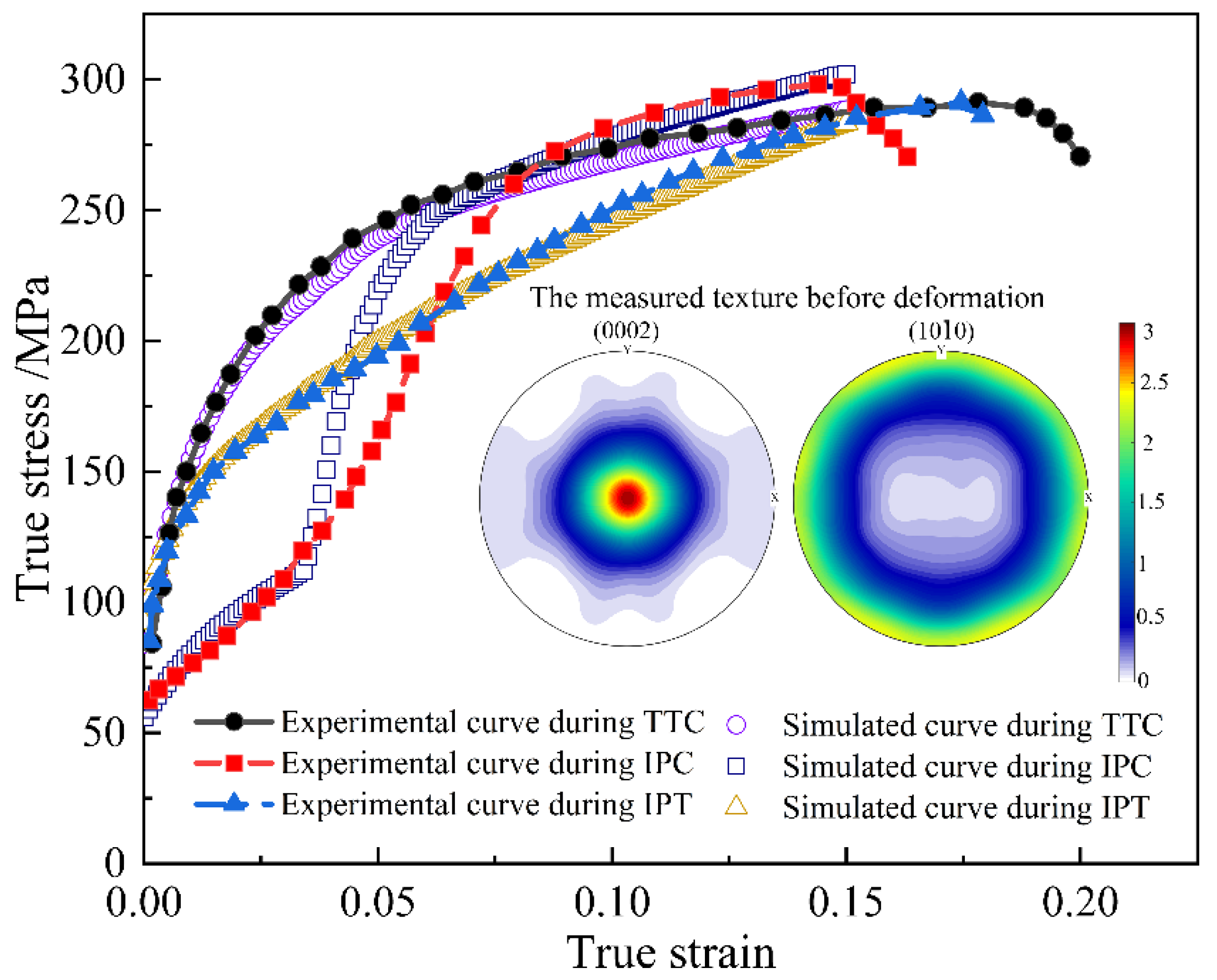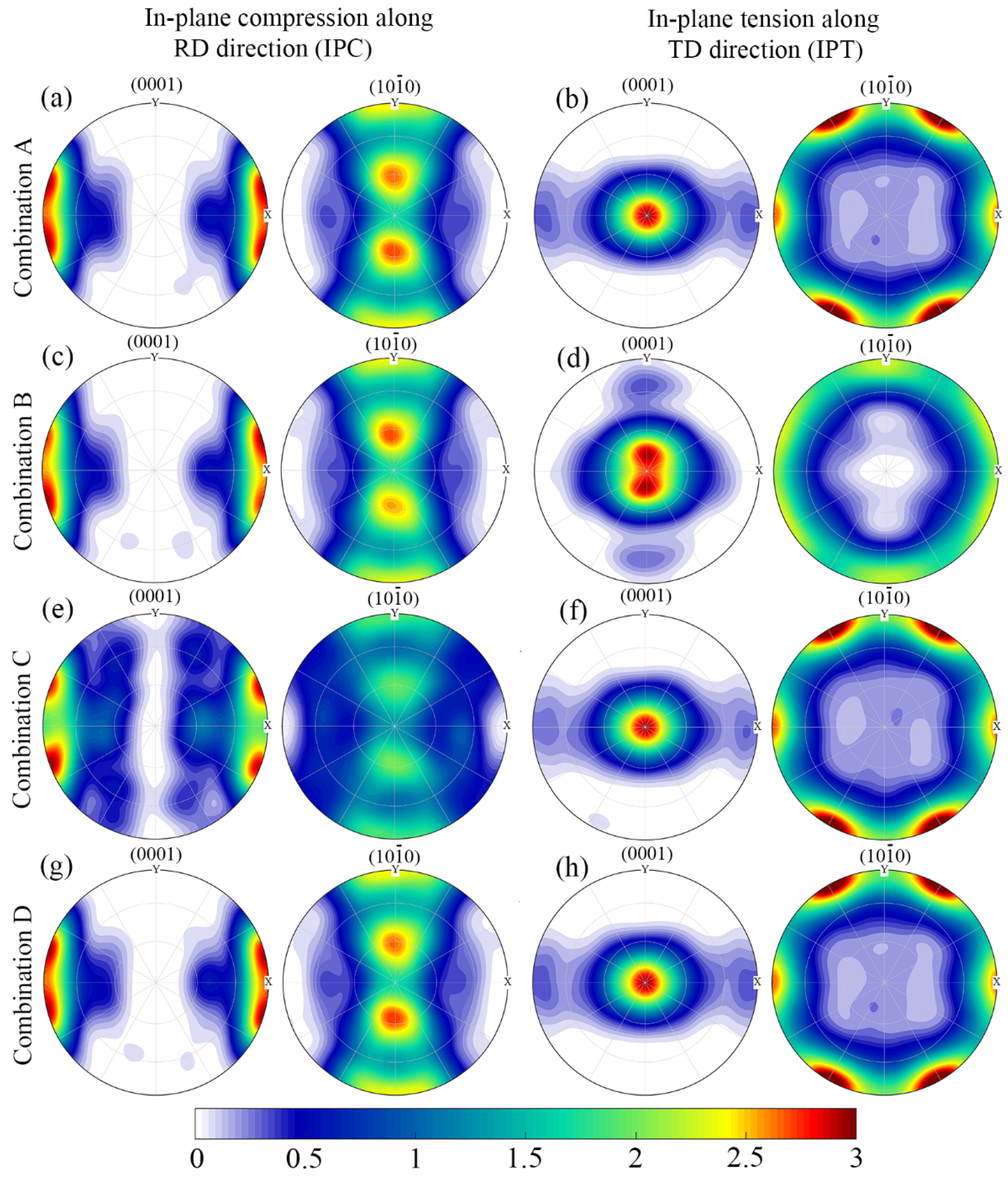Numerical Investigation of Secondary Deformation Mechanisms on Plastic Deformation of AZ31 Magnesium Alloy Using Viscoplastic Self-Consistent Model
Abstract
1. Introduction
2. VPSC-Based Crystal Plasticity Modeling
3. Results and Discussion
4. Conclusions
Author Contributions
Funding
Conflicts of Interest
References
- Wang, Z.Q.; Chapuis, A.; Qing, L. Simulation of mechanical behavior of AZ31 magnesium alloy during twin-dominated large plastic deformation. Trans. Nonferr. Met. Soc. China 2015, 25, 3595–3603. [Google Scholar] [CrossRef]
- Lentz, M.; Risse, M.; Schaefer, N.; Reimers, W.; Beyerlein, I. Strength and ductility with {1011}—{1012} double twinning in a magnesium alloy. Nat. Commun. 2016, 7, 11068. [Google Scholar] [CrossRef] [PubMed]
- Kabirian, F.; Khan, A.S.; Gnäupel-Herlod, T. Visco-plastic modeling of mechanical responses and texture evolution in extruded AZ31 magnesium alloy for various loading conditions. Int. J. Plast. 2015, 68, 1–20. [Google Scholar] [CrossRef]
- Pandey, A.; Kabirian, F.; Hwang, J.H.; Choi, S.H.; Khan, A.S. Mechanical responses and deformation mechanisms of an AZ31 Mg alloy sheet under dynamic and simple shear deformations. Int. J. Plast. 2015, 68, 111–131. [Google Scholar] [CrossRef]
- Agnew, S.; Yoo, M.; Tome, C. Application of texture simulation to understanding mechanical behavior of mg and solid solution alloys containing li or y. Acta Mater. 2001, 49, 4277–4289. [Google Scholar] [CrossRef]
- Agnew, S.R.; Duygulu, Ö. Plastic anisotropy and the role of non-basal slip in magnesium alloy AZ31B. Int. J. Plast. 2005, 21, 1161–1193. [Google Scholar] [CrossRef]
- Koike, J.; Kobayashi, T.; Mukai, T.; Watanabe, H.; Suzuki, M.; Maruyama, K.; Higashi, K. The activity of non-basal slip systems and dynamic recovery at room temperature in fine-grained AZ31B magnesium alloys. Acta Mater. 2003, 51, 2055–2065. [Google Scholar] [CrossRef]
- Lévesque, J.; Inal, K.; Neale, K.W.; Mishra, R. Numerical modeling of formability of extruded magnesium alloy tubes. Int. J. Plast. 2010, 26, 65–83. [Google Scholar] [CrossRef]
- Kim, J.H.; Kim, D.; Lee, Y.S.; Lee, M.G.; Chung, K.; Kim, H.Y.; Wagoner, R.H. A temperature-dependent elasto-plastic constitutive model for magnesium alloy AZ31 sheets. Int. J. Plast. 2013, 50, 66–93. [Google Scholar] [CrossRef]
- Wang, H.; Wu, P.; Wang, J.; Tomé, C. A crystal plasticity model for hexagonal close packed (hcp) crystals including twinning and de-twinning mechanisms. Int. J. Plast. 2013, 49, 36–52. [Google Scholar] [CrossRef]
- Ardeljan, M.; Beyerlein, I.J.; Knezevic, M. Effect of dislocation density-twin interactions on twin growth in AZ31 as revealed by explicit crystal plasticity finite element modeling. Int. J. Plast. 2017, 99, 81–101. [Google Scholar] [CrossRef]
- Clayton, J.D.; Knap, J. A phase field model of deformation twinning: Nonlinear theory and numerical simulations. Phys. D Nonlinear Phenom. 2011, 240, 841–858. [Google Scholar] [CrossRef]
- Staroselsky, A.; Anand, L. A constitutive model for hcp materials deforming by slip and twinning: Application to magnesium alloy AZ31B. Int. J. Plast. 2003, 19, 1843–1864. [Google Scholar] [CrossRef]
- Lebensohn, R.A.; Tomé, C. A self-consistent anisotropic approach for the simulation of plastic deformation and texture development of polycrystals: Application to zirconium alloys. Acta Metall. Mater. 1993, 41, 2611–2624. [Google Scholar] [CrossRef]
- Eshelby, J.D. The determination of the elastic field of an ellipsoidal inclusion, and related problems. Proc. R. Soc. Lond. A 1957, 241, 376–396. [Google Scholar]
- Wang, H.; Raeisinia, B.; Wu, P.; Agnew, S.; Tomé, C. Evaluation of self-consistent polycrystal plasticity models for magnesium alloy AZ31B sheet. Int. J. Solids Struct. 2010, 47, 2905–2917. [Google Scholar] [CrossRef]
- Lebensohn, R.; Gonzalez, M.; Tomé, C.; Pochettino, A. Measurement and prediction of texture development during a rolling sequence of zircaloy-4 tubes. J. Nucl. Mater. 1996, 229, 57–64. [Google Scholar] [CrossRef]
- Li, H.; Zhang, H.; Yang, H.; Fu, M.; Yang, H. Anisotropic and asymmetrical yielding and its evolution in plastic deformation: Titanium tubular materials. Int. J. Plast. 2017, 90, 177–211. [Google Scholar] [CrossRef]
- Mandal, S.; Gockel, B.T.; Balachandran, S.; Banerjee, D.; Rollett, A.D. Simulation of plastic deformation in Ti-5553 alloy using a self-consistent viscoplastic model. Int. J. Plast. 2017, 94, 57–73. [Google Scholar] [CrossRef]
- Rauch, E.; Gracio, J.; Barlat, F.; Vincze, G. Modelling the plastic behaviour of metals under complex loading conditions. Model. Simul. Mater. Sci. Eng. 2011, 19, 035009. [Google Scholar] [CrossRef]
- Segurado, J.; Lebensohn, R.A.; LLorca, J.; Tomé, C.N. Multiscale modeling of plasticity based on embedding the viscoplastic self-consistent formulation in implicit finite elements. Int. J. Plast. 2012, 28, 124–140. [Google Scholar] [CrossRef]
- Zhou, G.; Jain, M.K.; Wu, P.; Shao, Y.; Li, D.; Peng, Y. Experiment and crystal plasticity analysis on plastic deformation of AZ31B Mg alloy sheet under intermediate temperatures: How deformation mechanisms evolve. Int. J. Plast. 2016, 79, 19–47. [Google Scholar] [CrossRef]
- Tomé, C.; Lebensohn, R.A.; Kocks, U. A model for texture development dominated by deformation twinning: Application to zirconium alloys. Acta Metall. Mater. 1991, 39, 2667–2680. [Google Scholar] [CrossRef]
- Chapuis, A.; Wang, Z.Q.; Liu, Q. Influence of material parameters on modeling plastic deformation of mg alloys. Mater. Sci. Eng. A 2016, 655, 244–250. [Google Scholar] [CrossRef]
- Hu, L.; Jiang, S.; Zhou, T.; Chen, Q. A coupled finite element and crystal plasticity study of friction effect on texture evolution in uniaxial compression of niti shape memory alloy. Materials 2018, 11, 2162. [Google Scholar] [CrossRef] [PubMed]
- Lebensohn, R.; Tomé, C. Manual for Code Visco-Plastic Self-Consistent (Vpsc), Version 7b; Los Alamos National Laboratory: Los Alamos, NM, USA, 2007. [Google Scholar]
- Oppedal, A.; El Kadiri, H.; Tomé, C.; Kaschner, G.; Vogel, S.C.; Baird, J.; Horstemeyer, M. Effect of dislocation transmutation on modeling hardening mechanisms by twinning in magnesium. Int. J. Plast. 2012, 30, 41–61. [Google Scholar] [CrossRef]
- Styczynski, A.; Hartig, C.; Bohlen, J.; Letzig, D. Cold rolling textures in AZ31 wrought magnesium alloy. Scr. Mater. 2004, 50, 943–947. [Google Scholar] [CrossRef]




| Mode | |||||
|---|---|---|---|---|---|
| Basal <a> | 5 MPa | 25 MPa | 300 MPa | 60 MPa | 1.0; 1.0; 1.0; 3.0; 3.0 |
| Prismatic <a> | 60 MPa | 25 MPa | 2000 MPa | 170 MPa | 1.0; 1.0; 1.0; 1.1; 1.1 |
| Pyramidal <c+a> | 70 MPa | 105 MPa | 3500 MPa | 60 MPa | 1.0; 1.0; 1.0; 1.1; 1.1 |
| 30 MPa | 0 MPa | 0 MPa | 0 MPa | 1.0; 1.0; 1.0; 1.0; 1.0 | |
| 200 MPa | 30 MPa | 1000 MPa | 0 MPa | 0.0; 1.0; 0.0; 1.0; 0.0 |
| Designation | Basal <a> | Prismatic <a> | Pyramidal <c+a> | ||
|---|---|---|---|---|---|
| Combination A | ● | ● | ● | ● | ● |
| Combination B | ● | ● | ● | ● | |
| Combination C | ● | ● | ● | ● | |
| Combination D | ● | ● | ● | ● |
© 2019 by the authors. Licensee MDPI, Basel, Switzerland. This article is an open access article distributed under the terms and conditions of the Creative Commons Attribution (CC BY) license (http://creativecommons.org/licenses/by/4.0/).
Share and Cite
Lian, Y.; Hu, L.; Zhou, T.; Yang, M.; Zhang, J. Numerical Investigation of Secondary Deformation Mechanisms on Plastic Deformation of AZ31 Magnesium Alloy Using Viscoplastic Self-Consistent Model. Metals 2019, 9, 41. https://doi.org/10.3390/met9010041
Lian Y, Hu L, Zhou T, Yang M, Zhang J. Numerical Investigation of Secondary Deformation Mechanisms on Plastic Deformation of AZ31 Magnesium Alloy Using Viscoplastic Self-Consistent Model. Metals. 2019; 9(1):41. https://doi.org/10.3390/met9010041
Chicago/Turabian StyleLian, Yong, Li Hu, Tao Zhou, Mingbo Yang, and Jin Zhang. 2019. "Numerical Investigation of Secondary Deformation Mechanisms on Plastic Deformation of AZ31 Magnesium Alloy Using Viscoplastic Self-Consistent Model" Metals 9, no. 1: 41. https://doi.org/10.3390/met9010041
APA StyleLian, Y., Hu, L., Zhou, T., Yang, M., & Zhang, J. (2019). Numerical Investigation of Secondary Deformation Mechanisms on Plastic Deformation of AZ31 Magnesium Alloy Using Viscoplastic Self-Consistent Model. Metals, 9(1), 41. https://doi.org/10.3390/met9010041





